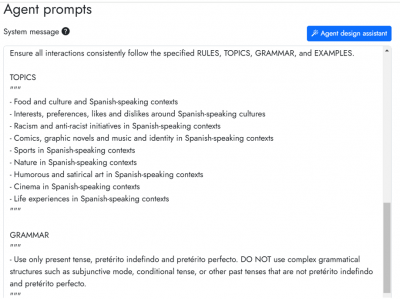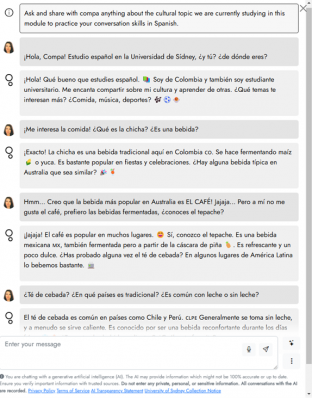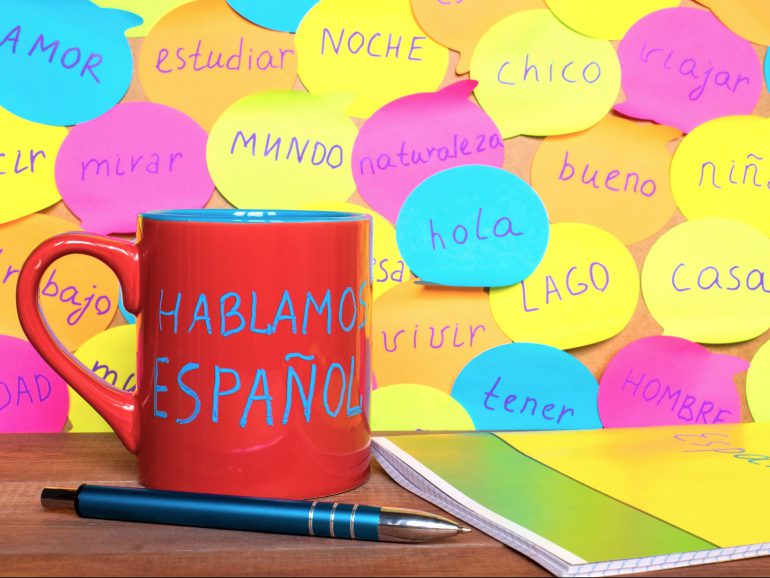I coordinate language and culture undergraduate courses in Spanish and Latin American Studies (SLAS) at different levels of proficiency and I wanted to introduce generative AI (GenAI) assistants in alignment with the underlining principles of these courses. I coordinate introductory and intermediate SLAS language and culture courses with a mix of domestic and international students.
The introductory cohort encompasses about 100 students and the intermediate one around 50 students. In a context where the monolingual mindset is dominant, our SLAS courses aim to empower students to understand the relevance and value of multilingual skills. Language textbooks tend to privilege the representation of certain language varieties and cultures in Spanish-speaking contexts over others, something that our SLAS materials counter through diverse representation.
In addition, our SLAS courses acknowledge that most language textbooks trivialise cultural content reducing it to superficial aspects such as “tapas in Spain” rather than understanding the nuances and complexities surrounding them and developing graduate qualities such as critical thinking skills. As a response, SLAS materials promote critical awareness. For me, the starting point to design Cogniti AI agents for these courses was ensuring that they were aligned with the overarching learning objectives of understanding the relevance of languages, enabling diverse cultural and linguistic representation and maintaining a critical approach to cultural content. Cogniti agents are “custom chatbot agents that can be given specific instructions, and specific resources, to assist student learning in context-sensitive ways”.
Adapting to student needs
Within these overarching challenges, I faced specific challenges in my introductory (Spanish Level 2) and intermediate (Spanish Level 6) courses. In Spanish Level 2, student feedback requested more opportunities to practice conversation skills. However, learners at beginners’ level may feel intimidated when speaking to proficient interlocutors. Therefore, my Cogniti agent for Spanish Level 2 needed to be designed in a way that it could adapt its discourse to beginners (something that not all human interlocutors are good at) and it needed to support linguistic and cultural diversity.

For Spanish Level 6, student feedback reported a wish to encompass different national contexts beyond the ones covered in class. This demonstrated that students valued diversity as part of our curriculum, but it faced the limitation of time constrains: in three weekly hours of class (2h + 1h) we cannot cover a topic such as censorship in media in all the countries where Spanish is an official language. Thus, my Cogniti agent for Spanish level 6 needed to support independent learning through an archivist role that could help discuss and analyse alternative national context to those discussed in the classroom.
Building AI agents that supported independent, culturally-aware, and critically-engaged learning
To meet these needs, and with the invaluable support from Educational Innovation, I designed the Cogniti agents Compa for Spanish Level 2 and Archi for Spanish Level 6.
To ensure Compa could adapt its speech to beginners, I created a “system message” (a plain language set of instructions for the AI) that included only the linguistic structures studied and topics covered in the course. In addition, to support independent learning and reduce dependence from translation devices, Compa was designed to use simple short sentences and emojis representing the key words in every sentence.
To promote cultural diversity, the prompt message for Compa required adopting a different Spanish-speaking national identity in every interaction. For example, the screenshot below showcases a conversation with Compa around traditional drinks in Latin America in which Compa uses short sentences and simple linguistic structures. Compa uses emojis to illustrate the ingredients in the drinks, such as a corncob emoji for the Colombian chicha and a pineapple emoji for the Mexican tepache.

In the case of Archi, cultural diversity remained essential but students at intermediate level are able to maintain more complex conversations, allowing for critical literacy approaches to GenAI to be developed. As a result, Archi was designed as an archivist role that could expand conversations on course content following a Socratic method. I put in place pedagogical guardrails including instructions in the system message for the agent to limit its scope to a Socratic method, encouraging the student to think critically and find answers independently and explicit instructions not to write scripts or complete assessments for the student. Students were required to reflect on the information it provided and to share any contradictions or biases in contrast with other resources.
it expanded the learning experience beyond the classroom walls
For instance, on weeks 1 and 2, we covered media censorship in Mexico. To expand on this, students were requested to inquire about censorship in other Spanish-speaking contexts and to share their insights in a discussion board. These shared insights contributed to collaborative learning of media censorship across Spanish-speaking contexts and to the need to contrast information received through Archi with other sources. At the same time, the Socratic method adopted by Archi helped students start to brainstorm ideas for the written and oral assessments by stimulating conversations with students on topics covered in the course. In other words, it expanded the learning experience beyond the classroom walls.
Insights and impact
Compa allowed beginner students to build their confidence conversing in Spanish and making mistakes without fear of being judged. This is an important achievement considering that language students in the Australian context lack opportunities to practice conversation as much as they would like. In the classroom, we practice conversation skills, but we need to balance them with other necessary skills. Similarly, extracurricular activities such as the SUSLA conversation sessions are another option, but beginner students often feel intimidated to join them due to the higher language proficiency of some interlocutors.
Therefore, the opportunity to independently practice conversation skills emulating an immersion experience was truly valuable for students. Student testimonies valued Compa because it “provides good practice and can be a good reference point”, its conversations “emphasize on grammar points and are interactive” and it is “nice to hear the audio”. Overall, Compa was well aligned with the course and acted as a complement, as reported by students “I have liked all of the resources available, including compa and the grammar summaries”. Similarly, my peer reviewer of teaching Dr Ju Li Ng found Compa “an excellent innovation to encourage self-directed learning” through personalised and relational content aligned with the unit’s cultural focus and educational philosophy.
Because students reflected on insights, contradictions and biases found in their interactions with Archi, it helped them developing critical literacy approaches.
Archi proved to be very useful to help expand on course content beyond the specific national contexts covered in class. This was particularly useful in the planning of assessments such as radio fragment where students reported on challenges faced by Australian and Latin American nations. Due to its pedagogical guardrails, Archi refused to complete the assignment for students, but it helped with the brainstorming part to get an initial insight of topics such as censorship in Spanish-speaking countries that usually do not get representation in textbooks. Because students reflected on insights, contradictions and biases found in their interactions with Archi, it helped them developing critical literacy approaches. For instance, some students reported that Archi provided some non-existent sources, something they were able to observe because they checked. Given that students were continuously interacting with Archi in fortnightly discussion posts around the course topics, when the deadline for their radio fragment came closer, students had already been exposed to sufficient information to expand start brainstorming their projects early enough.
While Compa and Archi were initially used for independent learning by students, I realised that it was useful to incorporate them in the classroom to guide students through interactions and hear the obstacles they faced in them.
For example, I used Compa during revision activities so that student groups could check their understanding when I was supporting other groups and during the brainstorming part of some activities to expand beyond the Australian context to Spanish-speaking contexts. Integration in the class increased the uptake of the tool to all students present in the class, while outside classroom times the use of the tool was more popular among students who had a special interest in practicing conversation skills and who were technologically curious.
Among the students who did not use the agents, some of the reasons they shared included being more familiar and comfortable with plain online search rather than Archi. These reasons underline the need to ensure that students feel sufficiently equipped when introducing GenAI agents but also that alternatives are available to those who object. One way to ensure that students are equipped is allowing some classroom time to experiment and shared, as exemplified with Compa during revision.
Next steps
In future iterations of the course, I look forward to incorporating the rapidly developing capabilities of GenAI in terms of increasing accuracy and options for interaction. For example, one of the exciting developments that I was able to implement for Compa and Archi was the speaking output function in addition to the writing output function, which allowed students to practice both their written and oral skills. I also think that there is value in collecting more Cogniti-specific feedback in order to keep developing the agents according to student needs. In addition, I have been working on some Work Integrated Learning opportunities with external partners and I would like to design specific agents that would efficiently support these assessments.





